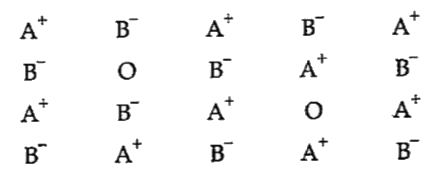What type of stoichiometric defect is shown by:
(i) ZnS (ii) AgBr
a. ZnS shows Frenel defect because its ions have a large difference in size.
AgBr shows both Frenkel and Schottky defects.
Topper's Solved these Questions
- NCERT BASED EXERCISEBOOK - CENGAGE CHEMISTRY ENGLISHCHAPTER - NCERT BASED EXERCISEEXERCISE - NCERT Exerise
25 Videos
- NCERT BASED EXERCISEBOOK - CENGAGE CHEMISTRY ENGLISHCHAPTER - NCERT BASED EXERCISEEXERCISE - Short Answer Type Questions
69 Videos
- GRIGNARD REAGENTS AND ORGANOMETALLIC REAGENTSBOOK - CENGAGE CHEMISTRY ENGLISHCHAPTER - GRIGNARD REAGENTS AND ORGANOMETALLIC REAGENTSEXERCISE - Exercises Archives (Linked Comprehension)
1 Videos
- NUCLEAR CHEMISTRYBOOK - CENGAGE CHEMISTRY ENGLISHCHAPTER - NUCLEAR CHEMISTRYEXERCISE - Archives Subjective
13 Videos
Similar Questions
Knowledge Check
What type of stoichiometric defecit is shoen by ZnS ?
ASchottky defectBFrenkel defectCBoth Frenkel and Schottky defectsDNon-stoichiometric defectExamine the given defected crystal

Answer the following questions:
What type of stoichiometric defect is shown in the crystal ?ASchottky defect, decreases, NaCl and KCl etcBFrenkel defect, increases, As and Si etcCSchottky defect, increases, As and Bi etcDFrenkel defect, decreases, NaCl, KCl etc
What type of stoichiometric defect is shown by AgCl ?
View SolutionWhat type of stoichiometric defect is shown by AgCl?
View Solution(i) (a) Following is the schematic alignment of magnetic moments :

What type of magnetism is shown by this substance ?
(b) What type of stoichiometric defect is shown by (i) KCI (ii) AgCl ?
(ii) An element with density 11.2gcm−3 forms a fcc lattice with length of 4×d10−8 cm. Calculate the atomic mass of the element. (NA=6.02×1023mol−1).
View SolutionWhat type of stoichiometric defect is shown by KCl and why ?
View SolutionWhat type of stoichiometric defect is shown by NaCl ? Explain.
View SolutionExamiine the given defective crystal

(i) What type of stoichiometric defect is shown by the the crystal ?
(ii) How is the density of the crystal affected by this defect ?
(iii) What type of ionic substance show such defect ?
View Solution
